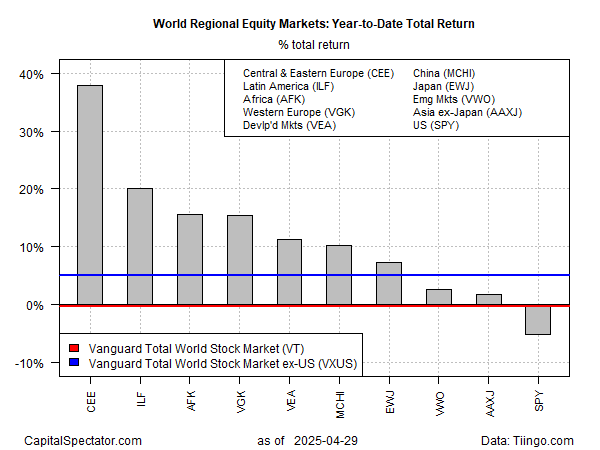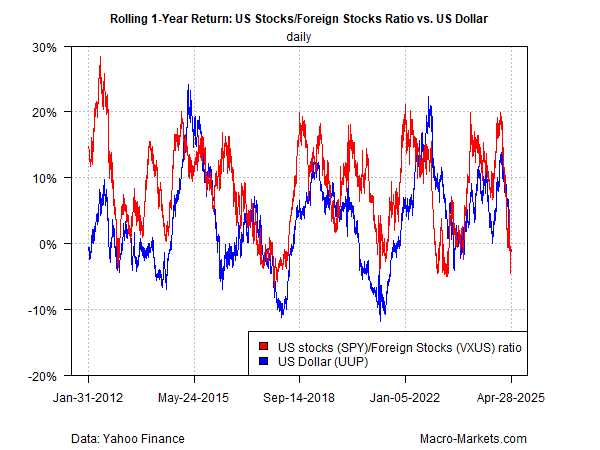International diversification remains a winning strategy for equities so far this year. Rallies in all the primary regions of the world continue to lead US shares, which are still posting a loss year for 2025, based on a set of ETFs through Tuesday’s close (Apr. 29).
The top-performing region: central and eastern Europe via a closed-end fund (there are no US-listed ETFs targeting the region).
The Central and Eastern Europe Fund (CEE) is up nearly 38% so far this year. That’s far ahead of the global ex-US benchmark (), which is ahead by 8.8%.
US stocks are the downside outlier this year, posting a 5.1% year-to-date decline, based on SPDR S&P 500 ETF (NYSE:).
Macro factors are playing an outsized role in the sharp divergence between foreign and US equities. The market appears to be pricing in higher risk related to the global trade war, and US shares are, so far, bearing the lion’s share of the shift. Put another way, investors are demanding a higher risk premium for US assets.
The change in sentiment is also expressed in the currency market, which is a factor for relative performance between US and foreign shares.
As I discussed yesterday in a note published at TMC Research, the sliding value of the this year has been a tailwind for the outperformance of global equities ex-US in recent history.
The chart above suggests that the relative outperformance of foreign shares may be peaking on a tactical basis. For the longer-term outlook, however, a regime shift could be unfolding with implications for the longer term. As I observed in Tuesday’s research note:
To the extent that the US dollar’s supremacy as the world’s reserve currency continues to ebb, the evolution provides greater support for maintaining an internationally diversified portfolio… If the dollar’s on track to play a lesser role in global finance, one implication is that owning non-dollar assets will become more attractive on the assumption that demand for foreign currencies will increase while holdings of dollars will decline, if only on the margins.
Although a sharp and relatively quick realignment of dollar-based reserves at central banks and investment accounts around the world is unlikely in the short term, the ongoing diversification of currency holdings that’s been underway for years appears set to continue.
Former Bridgewater chief investment strategist Rebecca Patterson also spies what may be a regime shift brewing. “I think there is a new risk premium on US assets as seen by foreign investors that did not exist before the ‘Liberation Day,’ maybe before the administration started,” she said.
The US dollar will remain a key factor for deciding if there’s a regime change unfolding, notes Vivekanand Jayakumar, an associate professor of economics at the University of Tampa.
“For the first time in recent memory, the American dollar is not the automatic “flight-to-safety” currency, sought out by investors worldwide during crisis periods and in moments of acute uncertainty.”
